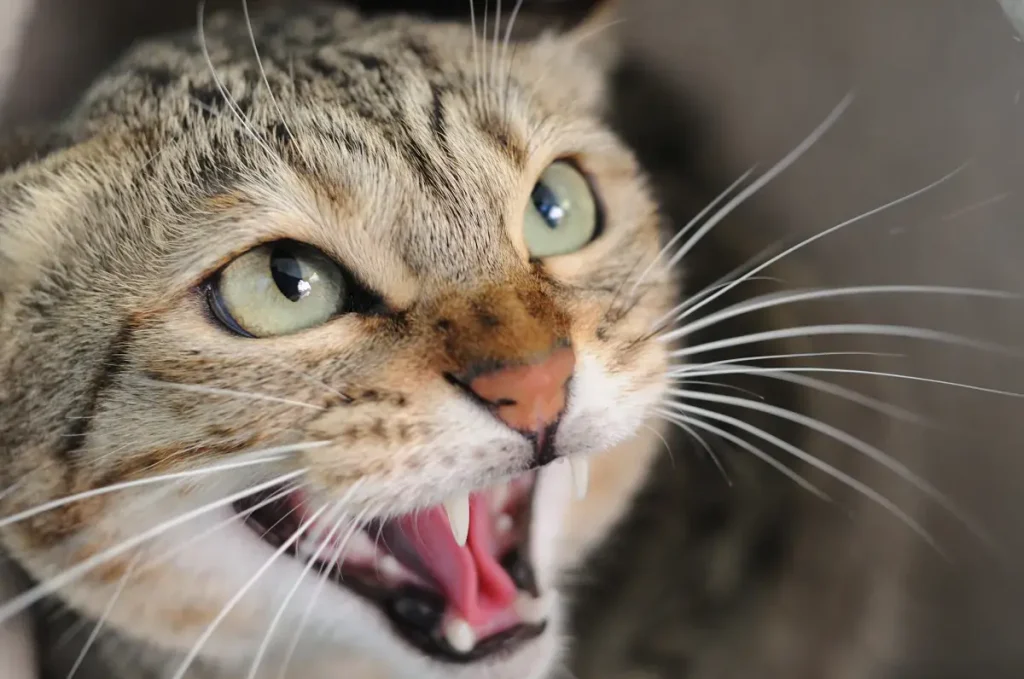When Dad’s Cat Just Won’t Be Your Friend: A Journey of Patience and Hisses
In a charming display of persistence that’s resonated with millions online, one woman’s quest to befriend her father’s standoffish cat has become an internet sensation. The viral TikTok video, shared by user @chancebeforetherapper, documents her determined attempts to win over Stripe, a blue-eyed tabby with a decidedly unfriendly disposition toward her. “Day one of trying to be best friends with my dad’s evil cat,” announces the text overlay, as viewers witness Stripe’s repeated hisses and clear signals of disinterest in forming this human-feline bond. The interaction only softens momentarily when the woman’s father physically holds Stripe, allowing for a brief, supervised petting session—though the cat’s expression, as described by the poster, remains one of “pure hatred.” What makes this scenario particularly relatable to cat owners everywhere is the poster’s plaintive caption: “I love cats and she hates me for no reason,” a sentiment that has struck a chord with the more than 1.7 million viewers who’ve watched this cross-species relationship struggle unfold.
The phenomenon of cats forming strong preferences for certain humans while actively disliking others is something many pet owners have experienced firsthand. Far from being random, these feline preferences often stem from how well humans respect their boundaries and autonomy. Cats, much like people, possess distinct personalities and tend to gravitate toward individuals whose temperaments complement their own. Their highly observant nature means they’re constantly assessing human behavior, forming opinions based on how we interact with them and the world around us. This selective sociability isn’t simply cats being difficult—it’s them exercising discernment about who earns their trust and affection, a process that requires humans to demonstrate patience and understanding rather than forcing interactions that make cats uncomfortable.
Past experiences significantly shape a cat’s willingness to trust particular people, creating patterns that can be challenging to overcome. If a cat associates negative encounters with someone who resembles a current person—whether in appearance, voice, or mannerisms—that historical wariness may transfer to the new relationship. Additionally, breed characteristics can predispose certain cats toward forming exclusive bonds; Bengals and Siamese cats, for example, are known for their tendency to become deeply attached to a single person while remaining aloof or even hostile toward others. These factors combine to create the complex social preferences we observe in our feline companions, explaining why the poster’s enthusiastic overtures toward Stripe were met with such clear resistance despite her genuine affection for cats in general.
The comments section of the viral video became an impromptu master class in feline psychology, with viewers offering advice that highlighted the importance of respecting a cat’s communication and boundaries. “Trying to force her to like you has only solidified her hatred. Leave her alone and I’m sure she’ll come around,” suggested one user named Bug, emphasizing the counterproductive nature of pushing unwanted interaction. Another commenter, Bailey Silva, provided more detailed guidance: “Don’t come up behind her like that, and when she’s giving you clear signs that she doesn’t want you to touch don’t touch. A little respect goes a long way with cats.” These insights reflect a fundamental truth about forming relationships with cats—they respond positively to those who honor their agency and allow them to initiate contact on their own terms, gradually building trust through consistent, respectful behavior rather than insistent approaches.
While some viewers joked about the implications of this feline favoritism—”We know who is getting the Inheritance,” quipped one commenter named Nick—the story ultimately contains a hopeful message about patience in relationship-building. In subsequent updates, the poster revealed that her persistence has begun to yield modest progress: though Stripe hasn’t transformed into an affectionate companion, she now tolerates being held without hissing and shows signs of slowly warming to her father’s visitor. This gradual thawing illustrates what cat behavior experts consistently emphasize—earning a cat’s trust requires time, respect for their boundaries, and attentiveness to their communication cues. By adjusting her approach based on Stripe’s comfort level, the poster has begun to establish the foundation for what might eventually become, if not friendship, at least a peaceful coexistence.
The remarkable popularity of this seemingly simple interaction—garnering hundreds of thousands of likes and millions of views—speaks to how deeply pet relationships resonate in our cultural consciousness. Beyond the humor of watching someone navigate the prickly personality of a resistant cat, viewers connect with the underlying themes of patience, respect, and the complexity of forming bonds across species barriers. The poster’s journey with Stripe reminds us that meaningful relationships, whether with humans or animals, cannot be forced but must be cultivated through mutual respect and understanding. While the video began as a lighthearted documentation of “day one” with an “evil cat,” it has evolved into a touching chronicle of small victories and gradual progress—a narrative that offers valuable lessons about connection, communication, and the special joy that comes from earning the trust of a creature initially determined to keep you at a distance.


